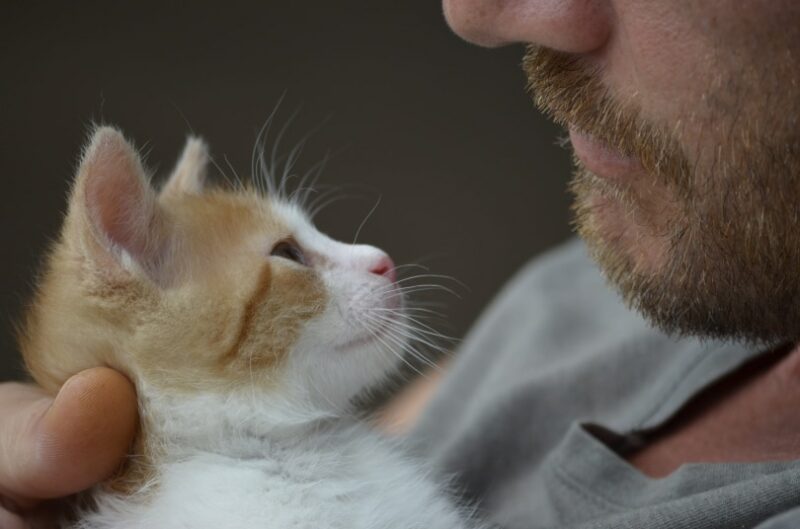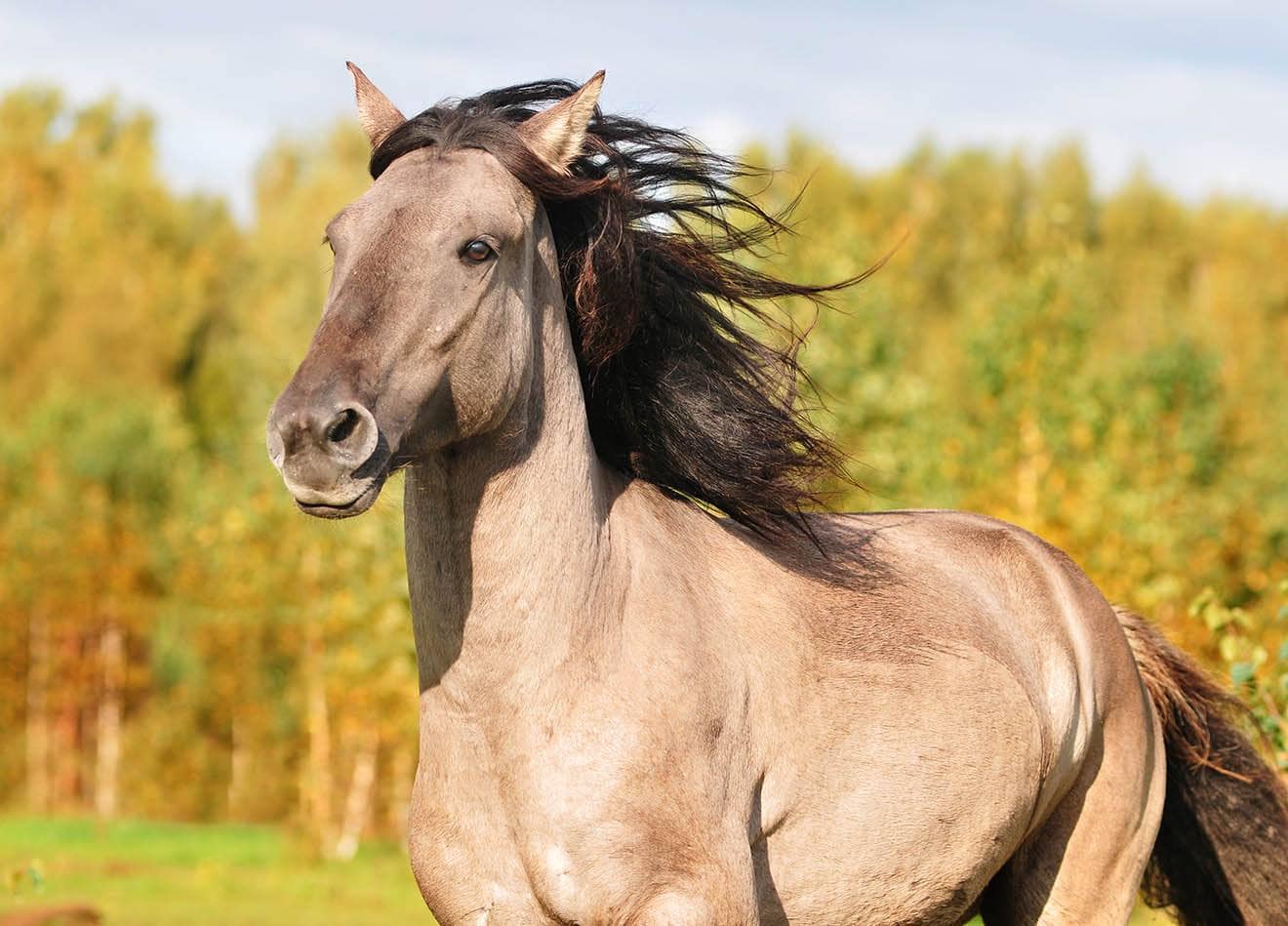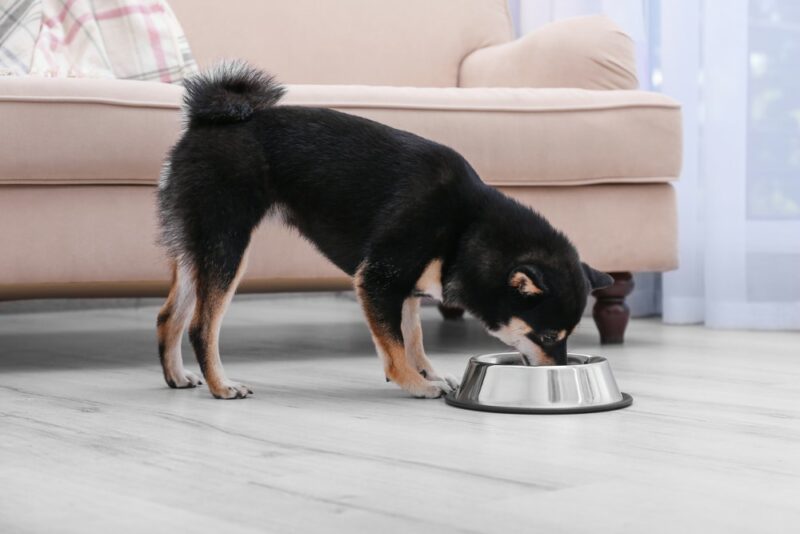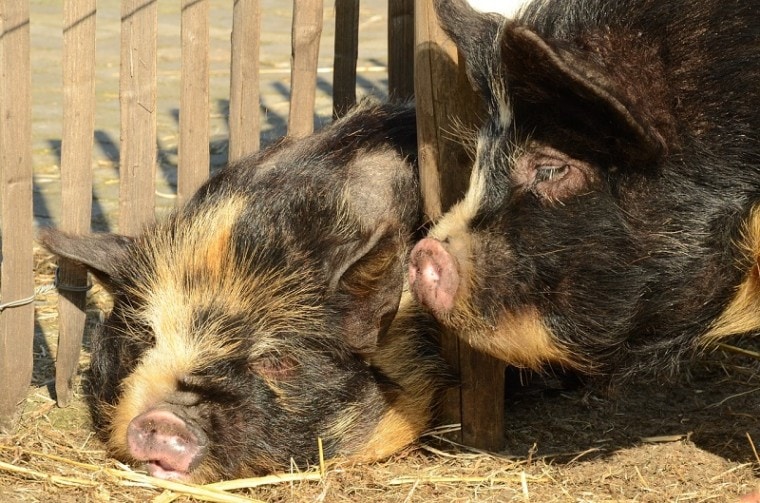
Potbellied pigs are large, affectionate, and intelligent pigs that are kept as a pet. They are charming and playful but are not good pets for everyone. These pigs are demanding and require special care that a typical person cannot provide for them. By choosing to take in a potbellied pig, you must understand how to meet their needs and care for them properly. It can be overwhelming to provide for your potbellied pig. They have a hearty appetite and high demand to be entertained. Many owners of potbellied pigs will claim they are more difficult to care for than their dogs and cats combined. Although they are not easy to care for, potbellied pigs provide a loving pet that you will learn to enjoy sharing your home with.
Keeping a potbellied pig healthy and entertained is important. This article will provide you with everything you should know when caring for a potbellied pig.
Potbellied Pig Facts
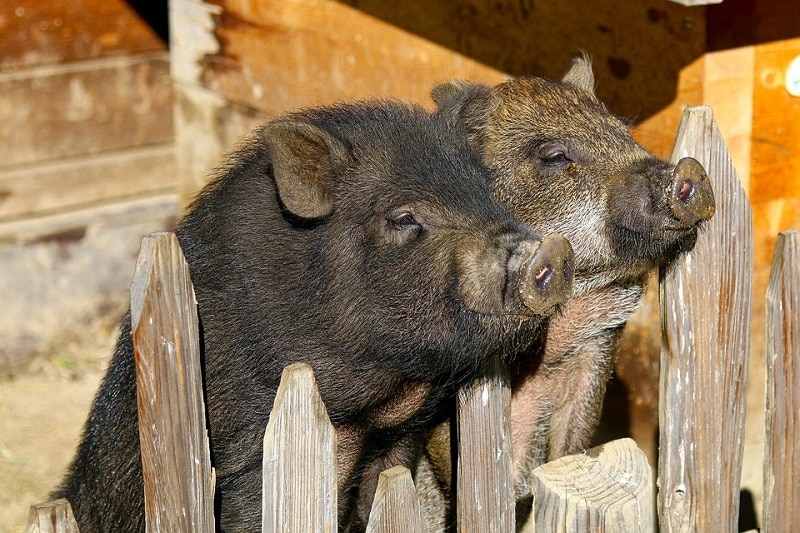
Potbellied pigs are a domestic breed of pig that originated from the Red River Delta from Vietnam in 1985. Their name ‘potbellied pig’ is derived from their low-hanging belly and short legs. There was a large amount of land populated by these pigs in various farm areas. Unfortunately, in 2010, their numbers diminished by nearly 80%. The FAO listed potbellied pigs as critically endangered back in 2007. To preserve these intelligent creatures, small numbers of pigs were exported to Canada and Sweden to be placed under laboratory use. Once potbellied pigs entered zoos for human viewing and species conservation, they quickly became a popular attraction and were then marketed as household or smallholder pets.
Due to the rise in ownership of these pigs, they became an invasive species in Spain in the last decade. This brings us to the present, where there are a variety of colorations and breeders who take pride in breeding quality potbellied pigs for the pet trade.
Potbellied pigs characterize an average weight of 70 to 200 pounds. They have a small head with a wrinkled, upturned snout. They have a curve in their back that supports their extended abdomen. Their jowls are heavy and sag towards the ground. Their upturned snout allows them to effectively forage for food. These pigs are resistant to a variety of diseases and parasites because of their filthy natural eating habits and wild living conditions.
Do Potbellied Pigs Make Good Pets?
Potbellied pigs make poor pets for the average household. They are new to being domesticated and still have their wild instincts that are hard to meet in captivity. Although potbellied pigs are hardy, they do poorly when kept in inadequate living conditions. With the accumulation of all the factors that come with their care, they are suitable for farms, smallholdings, and large farm-style lands. Your potbellied pig will not thrive in an apartment or modern house. The urban life has yet to be deemed suitable for these pigs and all efforts should be made to incorporate small amounts of their wild conditions into their life as pets.
Potbellied pigs depend heavily on their owner and are demanding when it comes to attention and entertainment. They are not self-sufficient and you as the owner will have to give up a large portion of your time to feed, enrich and entertain them. This can include time out of your work and social life to look after potbellied pigs appropriately.
A potbellied pig will not thrive in a small, modernized backyard, and nor will they do well if kept solely indoors. If you live on a farm with a large portion of open and secured land, a potbellied pig can successfully be kept as a pet. Although potbellied pigs are friendly and safe around children under strict adult supervision, they are not great pets to get for a young child to care for. Not only will your child struggle to make time for the pig, but a lot of effort also needs to go into their care that the typical child will not be able to achieve.
It is important to understand that these pigs are also messy and have the potential to outlive your dog and cat by several years. They will get up to mischief in the home and need to be watched during their active hours when they are not secluded inside of their pen or tent. Your countries weather conditions are another important aspect to consider before getting a potbellied pig. Snow and harsh rains that lead to frequent flooding on the land are unsuitable for a potbellied pig. Harsh summers can be catered for by providing them with constant access to various methods to cool them down. This includes mud puddles, sprinklers, and coverage.
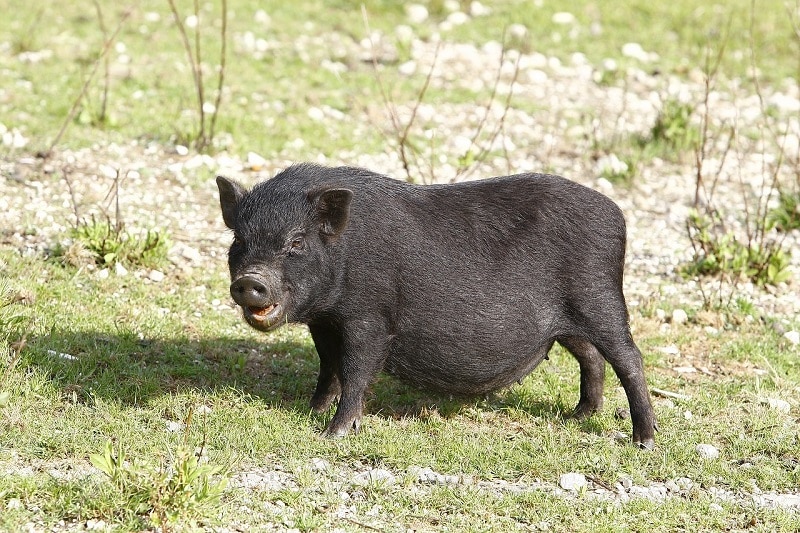
Where Can I Get a Potbellied Pig?
Potbellied pigs are available at high-ranked exotic pet stores or from reputable pet pig breeders. Many pet stores will not sell potbellied pigs. This is because they are cautiously watched under the RSPCA or SPCA pet trade laws and legislation. If you live in an area that has many wild potbellied pigs, you can expect to see captive-bred pigs more frequently in a pet store. It is ideal to investigate adopting a pig rather than buying one from a pet store.
Since many owners will get a pet pig and realized a few months or years down the line how much work these creatures require, they are frequently discarded by the means of illegally releasing them into the surrounding area, selling or placing them up for adoption on a pet rehoming sites. You may also find your area has a local pet pig rescue organization that will let you adopt out one of the potbellied pigs under their care. They may come with a small adoption fee and a home check before any papers can be signed.
Reputable potbellied pig breeders are one of the most common ways of acquiring these pigs. The only downfall is that these breeders will usually charge a large sum of money for their pigs. This can be induced by selling them under fancy names and backyard breeding for money. An ethical pig breeder will happily provide you with care sheets, genetic history and generally give off a passion for proper care and responsible ownership for potbellied pigs. Avoid supporting breeders who use incorrect names and terminology to sell their stock for a higher price and seem uninterested in the overall health and well-being of their pigs.
How Much Does It Cost to Own a Potbellied Pig?
Since potbellied pigs are a form of exotic pets, they are quite expensive to care for. Their food will have to be prepared by you with ingredients from your local supermarket. If you do not have time to make daily meals for your pig from scratch, you can purchase a pre-made mix from a breeder or local supplier to which you can refrigerate for that week. The mixes may cost anywhere between $20 to $40 either weekly or bi-weekly.
If you decide to make the food on your own, each ingredient component can be anywhere between $15 to $30, considering that you have most of the ingredients at home already. The potbellied pig’s home will consist of a coverage shelter, shallow kiddies pool, tent, and pen. This can add up to an estimate of $250 to $400. Nesting material is also needed to create a comfy sleeping area for your pig, this will be an additional cost depending on the type you decide to use. Potbellied pigs cost more than the average cat or dog.
Like all pets, potbellied pigs require access to an expert exotic vet. They will need health check-ups at least three times a year for a healthy pig, and frequently for a special needs or poorly pig. Depending on what the vet must do, you can expect to pay $80 to $100 for a general check-up and $200 to $700 for surgeries, medications, and vet interventions.
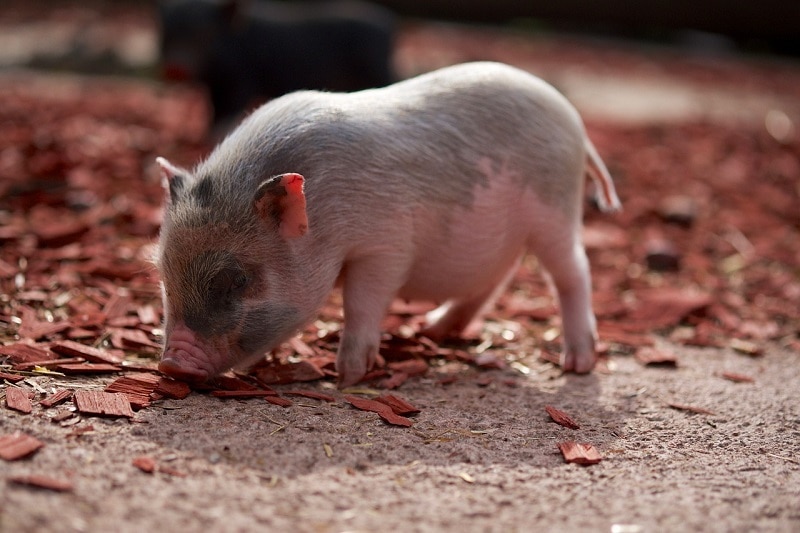
What Kind of Home Does My Potbellied Pig Need?
Potbellied pigs require a lot of space to be content. Unfortunately, this space does not mean the indoors of an apartment or modern house. Farmland is the best option for potbellied pigs. Potbellied pigs do not have to only be kept indoors, they can happily switch between sleeping in the house and spending the rest of the day outdoors. Your pig should have constant access to various enrichment items and a cozy shelter from the elements.
Your pig will happily lie on a large dog bed inside of your house during the night and periodically throughout the day. Your pig should have constant access to a shallow kiddie’s pool with fresh water. The pool should be large enough to fit the entire body of your pig, but shallow enough that they can lie down in it without having their snout covered. If your pig gets too hot, it can get heatstroke which will require immediate vet treatment. Shade is especially important for your potbellied pig; this can be achieved by a tent or homemade metal roof with hay or straw underneath. A small mud patch should be available so your potbellied pig can roll around in it and find some entertainment.
If you go to work during the day, your potbelly pig should be placed in a large and secure pen. The pen should include a shelter, shade, and a shallow kiddie’s pool. The pen should have enriching toys like dog tunnels, foraging opportunities, and mud puddles. A bowl of clean freshwater is necessary for your potbelly pig to drink from and hydrate itself.
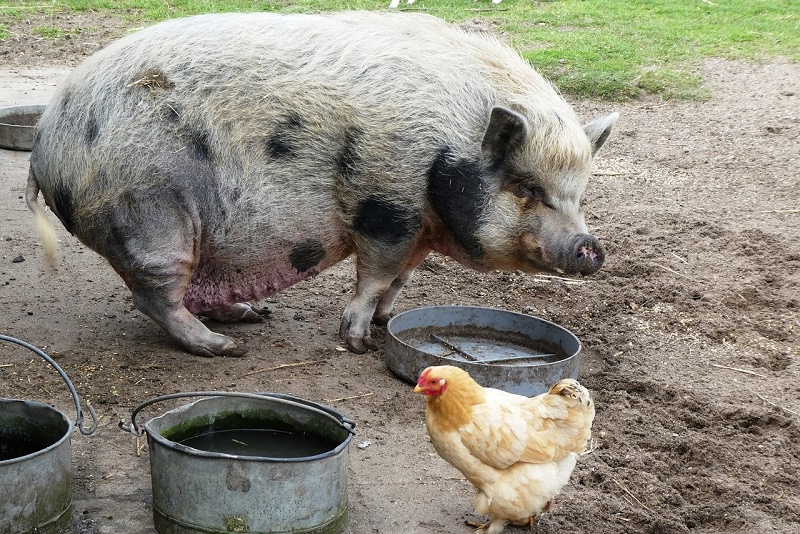
What Should I Feed My Potbellied Pig?
Your potbellied pig’s diet depends on the age of your pig. Each stage of your pig’s growth is aided by certain ingredients in your potbelly pig’s food.
We recommend purchasing a mix from a pig breeder with the following components:
Pet stores sell temporary commercial pig foods, but these mixes are not varied or suitable enough for your potbellied pig. Purchasing a mix from a quality pig mix outlet is your best option when it comes to feeding your pig. Growing pigs require diets suitable for their high energy consumption. Homemade diets for your potbellied pig are tricky to put together and your pig will do poorly if the food is lacking even a minimal amount of minerals, vitamins, and amino acids. You only must feed your potbellied pig once a day. A common issue is when owners overfeed their pigs with foods high in calories. After mealtime, your pig may have occasional healthy treats. Your potbellied pig should be putting on a decent amount of both muscle and fat.
If your pig is overweight, more health issues will take a toll on your pig. Potbellied are also very susceptible to stomach ulcers and therefore it is best to feed them pellets or a coarsely ground-up diet as the better option. Medicated diets are dangerous for your potbellied pig and should be avoided. Avoid all types of pig diets that have an antibiotic in them. A sickly pig should only have prescribed antibiotics from an agriculture veterinarian.
Tap or bottled water is safe for your pig to drink and they should have constant access to debris and mud-free water. Using a metal dog water bowl will make it hard for your pig to tip over. The water should be always kept cool and be placed in the shade.
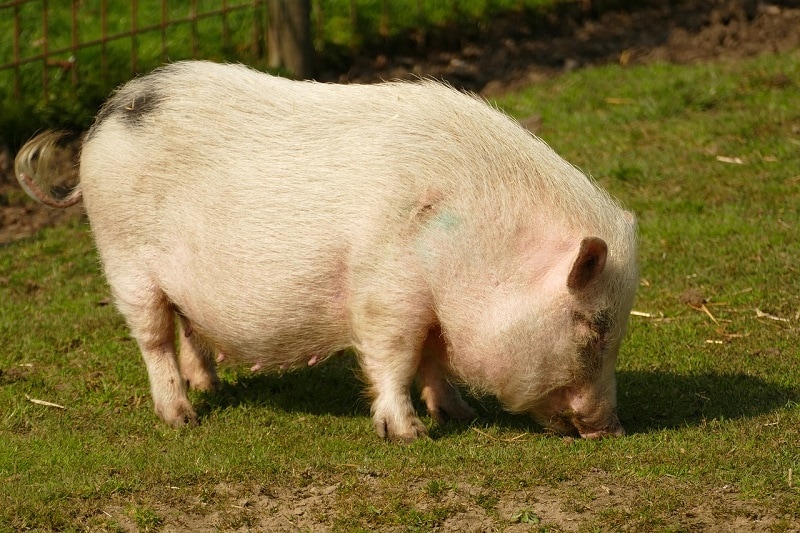
How Do I Take Care of My Potbellied Pig?
Feeding
Feed your pig once a day with a quality pig mix. Only feed healthy treats like vegetables and even a bowl of raw egg. Talk to your vet about the best diet for the size of your potbellied pig and when you should make changes according to the rate of your pigs’ growth and weight.
Cleaning
Your pig can be cleaned under a hose if they get dirty. If your pig comes inside of your house, place a long towel on the floor so some dirt can be caught in the towel instead of being walked around the house. Pigs are particularly messy, and their pen, tent, and bed should be cleaned often. You can wash fabric dog beds, blankets, and a scoop of their substrate and refill with clean fresh hay or straw once a week. The kiddie’s pool should be emptied every three days as it will accumulate a lot of mud and dirt. Your pig’s waste should be shoveled to keep the surrounding area clean.

Temperature
Your potbellied pig should be kept cool. They appreciate a bit of sunshine but need to stay in shade and be able to lay down in the kiddie’s pool. Keep your pig out of snow, bad rains, floods and keep them inside during heat waves.
Exercise
Toys and large spaces will keep your pig exercised. If you can walk around the garden with a treat, you can encourage them to get a few laps in to keep their muscles strong and healthy. Enriching items that they can explore works well. This can include foraging mats, tunnels, mud puddles, and low ramps.
Socialization
You should aim to spend at least an hour each day interacting with your potbellied pig. This allows them to socialize and show affection. If your potbellied pig is left alone for a period, it can start to become inactive and depressed. Other animals like dogs also make great socialization opportunities for your pig.

Vaccinations
Pet pigs require vaccinations from the young age of 5 weeks old. The Atrophic Rhinitis injection is recommended. You should also regularly have your pig vaccinated for rabies and tetanus. There are a variety of vaccinations your vet may recommend depending on the viruses most seen in pigs from the area. Some of the injections for E. coli, Rotavirus, Haemophilus, and TGE should be boosted in a month as directed by the vet.
How Do I Know If My Potbellied Pig Is Sick?
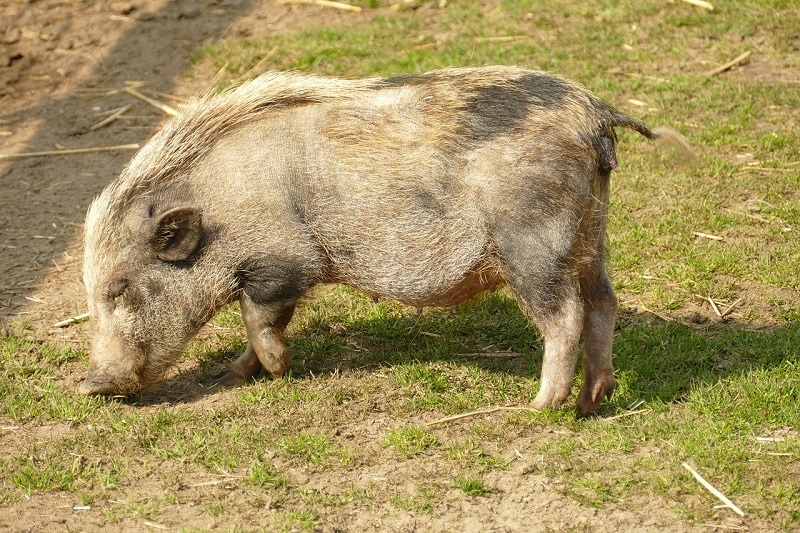
Final Thoughts
If you maintain your potbellied pigs living conditions and give them plenty of enrichment and socialization, you will be rewarded with a healthy potbellied pig. It is essential to get them checked by a qualified vet before you decide on the correct diet and vaccinations your potbellied pig will require. Keep their living conditions clean to avoid possible infections.
Potbellied pigs will be a welcomed pet and loved by the whole family. Their inquisitive nature and energy are a joy to have around the home.
Featured Image Credit: MrsBrown, Pixabay



